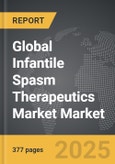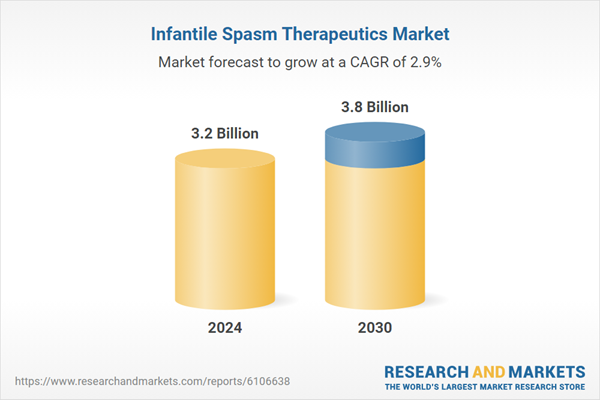Global Infantile Spasm Therapeutics Market - Key Trends & Drivers Summarized
Why Is Infantile Spasm Emerging as an Urgent Therapeutic Priority?
Infantile spasm, also known clinically as West syndrome, has moved to the forefront of pediatric neurology because of its devastating developmental consequences, its complex neurophysiology, and its increasing visibility through improved diagnostic vigilance. The disorder typically strikes within the first year of life, presenting with clusters of brief but explosive axial contractions that are easily mistaken for benign startle reflexes, gastroesophageal reflux posturing, or simple myoclonic jerks until developmental arrest or regression becomes undeniable. Neurophysiologists now recognize a distinctly chaotic electroencephalographic signature called hypsarrhythmia, and widespread deployment of video EEG monitoring units in neonatal intensive care settings is driving earlier detection. Epidemiological data suggest an incidence of roughly two to four cases per ten thousand live births, yet prevalence is amplified in regions with high rates of perinatal hypoxic-ischemic injury, tuberous sclerosis complex, or prenatal infections - all factors that remain stubbornly common in many low-- and middle-income countries. Untreated or suboptimally managed spasms progress rapidly to cognitive impairment, refractory epilepsy, and autism-spectrum behaviors, making prompt therapeutic intervention essential for neurodevelopmental preservation. Caregiver advocacy groups and social media communities have amplified the voices of parents who describe sudden loss of eye contact, developmental plateau, and catastrophic EEG findings, pressing health systems to shorten referral times from primary care to pediatric epilepsy specialists. Consequently, clinicians now face both ethical and logistical imperatives to initiate disease-modifying therapy within days rather than months of symptom onset, reshaping treatment paradigms and elevating infantile spasm therapeutics to a public health priority.Can Scientific Innovation Transform Treatment Outcomes Beyond Traditional Hormonal Protocols?
Contemporary management of infantile spasm is evolving well beyond legacy protocols centered on adrenocorticotropic hormone and oral corticosteroids, both of which can terminate spasms but carry risks of hypertension, immunosuppression, and reversible brain atrophy. Precision pharmacology has introduced vigabatrin, a selective irreversible inhibitor of gamma-aminobutyric-acid transaminase, as the first-line option for spasms associated with tuberous sclerosis complex and as a key second-line therapy in cryptogenic cases. Ongoing phase III trials are evaluating next-generation GABA-ergic analogues that maintain seizure suppression while minimizing irreversible visual field defects, a notorious complication seen with high cumulative vigabatrin exposure. Investigators are also assessing ganaxolone, a synthetic neurosteroid modulating synaptic and extrasynaptic GABA-A receptors, which has shown promising open-label efficacy when combined with prednisolone. Elsewhere, mTOR pathway inhibitors such as everolimus are being repurposed from oncology to address the upstream dysregulation underlying tuberous sclerosis-related epileptogenesis, offering a disease-targeted alternative rather than purely symptomatic control. Interest in gene-specific therapies is mounting, with antisense oligonucleotides being explored for CDKL5 deficiency and STXBP1 encephalopathy, both high-risk genotypes for early infantile spasms. Neuromodulation strategies are advancing as well: responsive neurostimulation for infants remains experimental, but deep brain stimulation targeting the centromedian thalamic nucleus has entered compassionate-use programs. Nutritional therapies are also under rigorous scrutiny; modified ketogenic protocols with precisely titrated medium-chain triglycerides are demonstrating spasm reduction while mitigating the metabolic burden of classic ketogenic diets. Collectively, these scientific advances are creating a multidimensional therapeutic landscape aimed not only at terminating spasms but also at altering the underlying neurodevelopmental trajectory, heralding a new era of precision and personalization in infantile spasm care.How Do Regulatory, Economic, and Caregiver Factors Influence Therapy Adoption and Accessibility?
The pathway from laboratory breakthrough to bedside impact in infantile spasm therapeutics is strongly mediated by regulatory frameworks, payer decisions, and the lived realities of caregivers. Designation of infantile spasm treatments as orphan drugs in the United States, Europe, and Japan confers market exclusivity, tax incentives, and abbreviated review timelines, accelerating entry of innovative agents yet often resulting in premium launch prices. Cost-utility analyses reveal that early seizure control yields long-term savings by reducing intensive developmental therapies and special-education services, prompting some national health authorities to reimburse expensive biologics when robust real-world evidence supports durable cognitive gains. Still, disparities persist: in many low-resource settings, availability of ACTH remains limited to compounded formulations with variable bioactivity, while vigabatrin tablets are frequently out of stock or unaffordable without humanitarian procurement channels. Tele-neurology platforms are beginning to bridge geographic gaps by connecting regional hospitals to tertiary epilepsy centers for rapid EEG interpretation and treatment initiation recommendations, although broadband penetration and clinician bandwidth remain limiting factors. Caregivers play an outsized role in treatment adherence, juggling complex steroid taper schedules, vigilant blood-pressure monitoring, and monthly ophthalmologic exams. Educational toolkits in multiple languages, text-message reminder systems, and peer-mentor programs have proven effective in sustaining adherence during the critical six-month consolidation window that follows therapy onset. Ethics committees and patient-advocacy councils influence trial design by demanding inclusion of neurodevelopmental endpoints alongside seizure metrics, ensuring that developmental quality-of-life considerations guide regulatory approvals. Collectively, these non-clinical forces shape market penetration and therapeutic equity, underscoring that breakthrough science must be paired with policy innovation and caregiver engagement to achieve population-level impact.What Is Driving the Accelerated Growth of the Infantile Spasm Therapeutics Market?
The growth in the infantile spasm therapeutics market is driven by several factors rooted in heightened diagnostic acuity, expanding genetic insights, progressive reimbursement policies, and a robust pipeline of targeted therapies that promise superior efficacy with manageable safety profiles. First, widespread adoption of high-resolution video EEG monitoring in newborn nurseries and emergency departments is identifying spasms earlier, enlarging the treatable population and emphasizing the value of rapid-acting agents. Second, next-generation sequencing panels are unmasking pathogenic variants that not only clarify prognosis but also point toward molecularly tailored interventions, accelerating investment in gene-specific therapeutics and companion diagnostics. Third, orphan-drug incentives and pediatric priority review vouchers are lowering commercial risk, encouraging biotech firms to pursue small-population indications with high unmet need. Fourth, real-world data from national epilepsy registries are providing compelling evidence that early intervention improves cognitive trajectories, prompting insurers and national health services to reimburse premium therapies and even fund home-based steroid administration programs. Fifth, strategic collaborations between pharmaceutical companies and academic epilepsy centers are streamlining phase II proof-of-concept studies through adaptive trial designs, shortening development timelines without compromising rigor. Sixth, the proliferation of caregiver advocacy networks is boosting public awareness, driving fundraising for research, and catalyzing policy reforms that facilitate medication importation and compassionate-use access. Seventh, emerging digital therapeutics that integrate seizure-detection wearables and AI-driven dosing algorithms are poised to complement pharmacologic regimens, opening ancillary revenue streams and reinforcing the overall market ecosystem. These interlocking drivers are collectively transforming infantile spasm therapeutics from a niche subspecialty concern into a vibrant, fast-growing domain of pediatric neuroscience innovation poised to deliver meaningful improvements in survival, cognition, and quality of life for affected infants worldwide.Report Scope
The report analyzes the Infantile Spasm Therapeutics market, presented in terms of market value (US$). The analysis covers the key segments and geographic regions outlined below:- Segments: Therapeutic Class (Anticonvulsants, Corticosteroids, Other Therapeutic Classes); Drug Type (Vigabatrin, Adrenocorticotropic Hormone, Other Drug Types); Dosage (Solid Dosage, Liquid Dosage).
- Geographic Regions/Countries: World; United States; Canada; Japan; China; Europe (France; Germany; Italy; United Kingdom; Spain; Russia; and Rest of Europe); Asia-Pacific (Australia; India; South Korea; and Rest of Asia-Pacific); Latin America (Argentina; Brazil; Mexico; and Rest of Latin America); Middle East (Iran; Israel; Saudi Arabia; United Arab Emirates; and Rest of Middle East); and Africa.
Key Insights:
- Market Growth: Understand the significant growth trajectory of the Anticonvulsants segment, which is expected to reach US$2.3 Billion by 2030 with a CAGR of a 2.7%. The Corticosteroids segment is also set to grow at 3.5% CAGR over the analysis period.
- Regional Analysis: Gain insights into the U.S. market, valued at $878.8 Million in 2024, and China, forecasted to grow at an impressive 5.4% CAGR to reach $743.7 Million by 2030. Discover growth trends in other key regions, including Japan, Canada, Germany, and the Asia-Pacific.
Why You Should Buy This Report:
- Detailed Market Analysis: Access a thorough analysis of the Global Infantile Spasm Therapeutics Market, covering all major geographic regions and market segments.
- Competitive Insights: Get an overview of the competitive landscape, including the market presence of major players across different geographies.
- Future Trends and Drivers: Understand the key trends and drivers shaping the future of the Global Infantile Spasm Therapeutics Market.
- Actionable Insights: Benefit from actionable insights that can help you identify new revenue opportunities and make strategic business decisions.
Key Questions Answered:
- How is the Global Infantile Spasm Therapeutics Market expected to evolve by 2030?
- What are the main drivers and restraints affecting the market?
- Which market segments will grow the most over the forecast period?
- How will market shares for different regions and segments change by 2030?
- Who are the leading players in the market, and what are their prospects?
Report Features:
- Comprehensive Market Data: Independent analysis of annual sales and market forecasts in US$ Million from 2024 to 2030.
- In-Depth Regional Analysis: Detailed insights into key markets, including the U.S., China, Japan, Canada, Europe, Asia-Pacific, Latin America, Middle East, and Africa.
- Company Profiles: Coverage of players such as Collins Aerospace, Emcore Corporation, FN Herstal, Geosense, Honeywell Aerospace and more.
- Complimentary Updates: Receive free report updates for one year to keep you informed of the latest market developments.
Some of the 47 companies featured in this Infantile Spasm Therapeutics market report include:
- Amneal Pharmaceuticals
- ANI Pharmaceuticals
- Biocodex SA
- Boehringer Ingelheim
- Catalyst Pharmaceuticals
- Cipla Limited
- Currax Pharmaceuticals LLC
- Dr. Reddy's Laboratories Ltd.
- GW Pharmaceuticals (Jazz Pharma)
- Hikma Pharmaceuticals Plc
- Ionis Pharmaceuticals
- Lupin Limited
- Mallinckrodt Pharmaceuticals
- Marinus Pharmaceuticals
- Medexus Pharmaceuticals Inc.
- Mylan (Viatris Inc.)
- Novartis AG
- Orion Corporation
- Pfizer Inc.
- Sun Pharmaceutical Industries Ltd.
This edition integrates the latest global trade and economic shifts into comprehensive market analysis. Key updates include:
- Tariff and Trade Impact: Insights into global tariff negotiations across 180+ countries, with analysis of supply chain turbulence, sourcing disruptions, and geographic realignment. Special focus on 2025 as a pivotal year for trade tensions, including updated perspectives on the Trump-era tariffs.
- Adjusted Forecasts and Analytics: Revised global and regional market forecasts through 2030, incorporating tariff effects, economic uncertainty, and structural changes in globalization. Includes historical analysis from 2015 to 2023.
- Strategic Market Dynamics: Evaluation of revised market prospects, regional outlooks, and key economic indicators such as population and urbanization trends.
- Innovation & Technology Trends: Latest developments in product and process innovation, emerging technologies, and key industry drivers shaping the competitive landscape.
- Competitive Intelligence: Updated global market share estimates for 2025, competitive positioning of major players (Strong/Active/Niche/Trivial), and refined focus on leading global brands and core players.
- Expert Insight & Commentary: Strategic analysis from economists, trade experts, and domain specialists to contextualize market shifts and identify emerging opportunities.
Table of Contents
Companies Mentioned (Partial List)
A selection of companies mentioned in this report includes, but is not limited to:
- Amneal Pharmaceuticals
- ANI Pharmaceuticals
- Biocodex SA
- Boehringer Ingelheim
- Catalyst Pharmaceuticals
- Cipla Limited
- Currax Pharmaceuticals LLC
- Dr. Reddy's Laboratories Ltd.
- GW Pharmaceuticals (Jazz Pharma)
- Hikma Pharmaceuticals Plc
- Ionis Pharmaceuticals
- Lupin Limited
- Mallinckrodt Pharmaceuticals
- Marinus Pharmaceuticals
- Medexus Pharmaceuticals Inc.
- Mylan (Viatris Inc.)
- Novartis AG
- Orion Corporation
- Pfizer Inc.
- Sun Pharmaceutical Industries Ltd.
Table Information
| Report Attribute | Details |
|---|---|
| No. of Pages | 377 |
| Published | November 2025 |
| Forecast Period | 2024 - 2030 |
| Estimated Market Value ( USD | $ 3.2 Billion |
| Forecasted Market Value ( USD | $ 3.8 Billion |
| Compound Annual Growth Rate | 2.9% |
| Regions Covered | Global |









